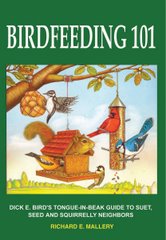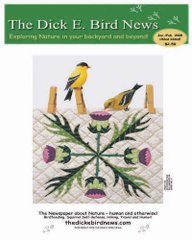
Feeding hummingbirds is as easy as making orange juice in the morning. If you mix your own nectar, use four parts water to one part sugar—refrigerate what you don’t use. Do not substitute honey for sugar. Honey can cause a fungus that has been known to affect the tiny bird’s tongue. You do not want to kill your birds with kindness. Do not use additives with your homemade nectar. Adding color and sweeteners will not help attract more birds and, in some cases, can be harmful.
Do not put a lot of nectar out until you notice they’re using it all. Sugar solutions are very susceptible to mold, harmful bacteria, and fermentation. Like suet, be careful to put out small amounts in shaded areas during hot weather.
Clean your hummingbird feeders regularly before each refill, using hot soapy water and a household bleach solution (one capful per gallon) or white vinegar, but rinse extremely well. If your feeder has hard-to-reach, grime-gathering grungy spots, add to the solution a dozen BBs or a handful of sand and shake, rattle, and roll. Another method used to clean feeder parts is soaking them in warm water and tossing in some denture cleaner. I guarantee it will put a smile on your hummingbird’s face.
If you clean your feeder with vinegar, feel free to swig a swill yourself. It can help your arthritis, aid digestion, lower cholesterol, grow hair on your bald spots, and soothe sprained muscles from squirrel chasing.
If you are looking for a jump-start on feeding hummers, because they haven’t shown up at your nectar feeder yet, try placing a flower box nearby. You don’t have to go out and buy a miniature Busch Gardens; a simple flower box will get the job done. Annuals are a good choice. They are often prolific and bloom longer. You don’t have to buy all red flowers; hummers like variety. Try putting some perching areas on your flower boxes. Studies show that hummers perch 60 percent of the time; they are just not noticed often in that position.
Hummingbirds weigh so little you could actually mail ten of them using a regular postage stamp. You will be surprised at how much these little egg beaters can consume. It takes a lot of energy to beat those wings as fast as they do. Their wings will go up and down 78 to 200 times per second, depending on what gear they are in. When they are in love they are in high gear.
If you watch closely, you will notice hummers do not suck the nectar from your feeder; they actually lick it out. When a hummer is thirsty, he can often get in 12 licks per second.
Now think about this: Hummers can beat their wings an average of 140 times per second, lick 12 times per second, breathe 4 times per second, and never look at the flowers they are eating from. At the same time they watch the one they plan to visit next and make sure no one else tries to beat them to it. These have to be very coordinated birds. They can fly forward, backward, up side down, and sideways. They can hover while picking and choosing which no-see-um to eat next, and then do aerial maneuvers that make the Blue Angels look like bush pilots. If you’re not feeding hummers, you’re missing the greatest show on Earth!
Do not put a lot of nectar out until you notice they’re using it all. Sugar solutions are very susceptible to mold, harmful bacteria, and fermentation. Like suet, be careful to put out small amounts in shaded areas during hot weather.
Clean your hummingbird feeders regularly before each refill, using hot soapy water and a household bleach solution (one capful per gallon) or white vinegar, but rinse extremely well. If your feeder has hard-to-reach, grime-gathering grungy spots, add to the solution a dozen BBs or a handful of sand and shake, rattle, and roll. Another method used to clean feeder parts is soaking them in warm water and tossing in some denture cleaner. I guarantee it will put a smile on your hummingbird’s face.
If you clean your feeder with vinegar, feel free to swig a swill yourself. It can help your arthritis, aid digestion, lower cholesterol, grow hair on your bald spots, and soothe sprained muscles from squirrel chasing.
If you are looking for a jump-start on feeding hummers, because they haven’t shown up at your nectar feeder yet, try placing a flower box nearby. You don’t have to go out and buy a miniature Busch Gardens; a simple flower box will get the job done. Annuals are a good choice. They are often prolific and bloom longer. You don’t have to buy all red flowers; hummers like variety. Try putting some perching areas on your flower boxes. Studies show that hummers perch 60 percent of the time; they are just not noticed often in that position.
Hummingbirds weigh so little you could actually mail ten of them using a regular postage stamp. You will be surprised at how much these little egg beaters can consume. It takes a lot of energy to beat those wings as fast as they do. Their wings will go up and down 78 to 200 times per second, depending on what gear they are in. When they are in love they are in high gear.
If you watch closely, you will notice hummers do not suck the nectar from your feeder; they actually lick it out. When a hummer is thirsty, he can often get in 12 licks per second.
Now think about this: Hummers can beat their wings an average of 140 times per second, lick 12 times per second, breathe 4 times per second, and never look at the flowers they are eating from. At the same time they watch the one they plan to visit next and make sure no one else tries to beat them to it. These have to be very coordinated birds. They can fly forward, backward, up side down, and sideways. They can hover while picking and choosing which no-see-um to eat next, and then do aerial maneuvers that make the Blue Angels look like bush pilots. If you’re not feeding hummers, you’re missing the greatest show on Earth!






No comments:
Post a Comment